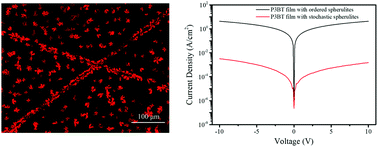Controlling the organization and stretchability of poly(3-butylthiophene) spherulites†
Abstract
In this work, we report a simple strategy to readily prepare poly(3-butylthiophene) (P3BT) films with patterned spherulites by brushing the P3BT film surface and annealing the film with carbon disulfide (CS2) vapor. The spherulites nucleated preferentially at the mechanically scratched areas over the unscratched region of the film. The ridge (formed at the side of the scratch) hinders the diffusion of the P3BT molecules, promoting the aggregation and nucleation of P3BT along the ridge to form spherulites upon the CS2 vapor-annealing. The sizes of the ridge and the scratch have no effect on the nucleation and crystallization of the patterned spherulites. We evaluated the crack formation of the P3BT films with patterned spherulites in response to mechanical stretching along different directions. When the stretching direction was parallel to the scratching direction, cracks appeared preferentially at the boundary between the ordered spherulites. In contrast, cracks occurred first at the boundary of stochastic nucleated spherulites located away from the patterned spherulites, when the stretching direction was perpendicular to the scratching direction. The patterned spherulites with regulated mechanical properties may find applications in the design and fabrication of stretchable organic optoelectronic devices with enhanced stability and durability.



 Please wait while we load your content...
Please wait while we load your content...